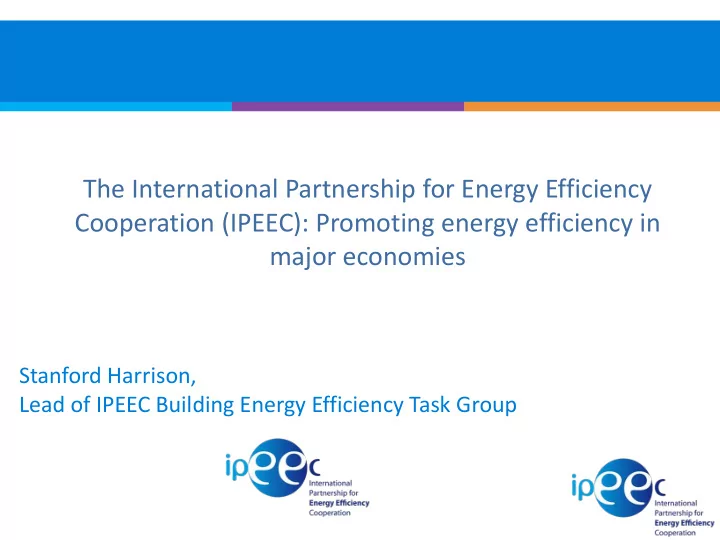

The International Partnership for Energy Efficiency Cooperation (IPEEC): Promoting energy efficiency in major economies Stanford Harrison, Lead of IPEEC Building Energy Efficiency Task Group
IPEEC - Background • Formally established in 2009 at the G8 summit in L'Aquila, Italy and resulting from successive meetings of the G8 + 6 economies. • Provides global leadership on energy efficiency by identifying and facilitating government implementation of policies and programs that yield high energy-efficiency gains. • Promotes information exchange on best practices and facilitates initiatives to improve energy efficiency. • Government led, voluntary contributions
IPEEC members
IPEEC is managing the G20 EE Agenda 1st Report to G20 Energy Ministers G20 Energy Efficiency Action Plan G20 EE Leading Programme Creation of International EE Hub
IPEEC runs 12 Task Groups
The Buildings Energy Efficiency Task Group • Collaborative platform for countries • Contribution to the work under the G20 Energy Efficiency Leading Programme • Projects to inform government policies and interventions • Work is consultancy-based with input from government contacts in IPEEC member nations
BEET and EBC: a comparison BEET EBC • Steady set of participants • Few engaged members • Large, task-shared projects as potential research base • Smaller, cost-shared projects • Mandate of IEA plus EBC ExCo countries • Mandate of G20 • Mostly technically • Policy oriented orientated • Government policy • Government and R&D officials officials
BEET reports • BEET 1: Building energy ratings • BEET 2: Opportunities for international collaboration • BEET 3: Building energy code implementation • BEET 4: Building energy performance metrics • BEET 5: Residential building energy efficiency ratings • BEET 6 (published soon): Regulatory policies for existing building energy renovations
Policy tools for government There are broadly three policy levers that government can use to deliver its policy outcomes: 1. Regulation 2. Expenditure and taxes 3. Information Each requires targeting so as to maximise impact and additionality, and minimise burden.
Hard evidence is needed “You can’t manage what you don’t measure” Peter Drucker “The only function of economic forecasting is to make astrology look more respectable” John Kenneth Galbraith
TCP value add for Government policy • Pathway to international standards • Evidence of what works • Adjusting to new technologies
Australia’s energy “trilemma” 1. Energy reliability 2. Energy affordability 3. Emission reductions Energy efficiency is not an end in itself but a contributor to the wider policy issues and directions.
Thank You! E-mail: contact@ipeec.org Tel: +33 (0)1 40 57 65 24 www.ipeec.org Follow IPEEC on:
Recommend
More recommend